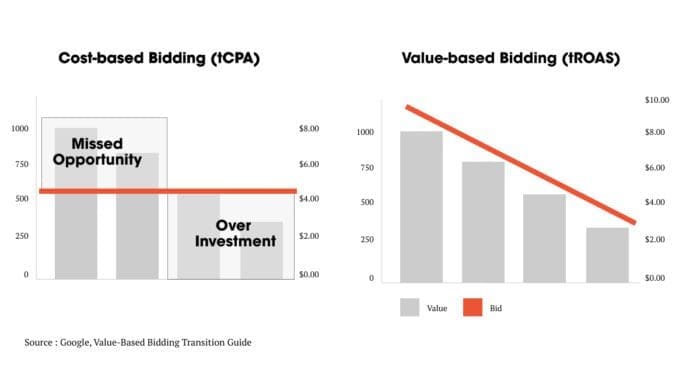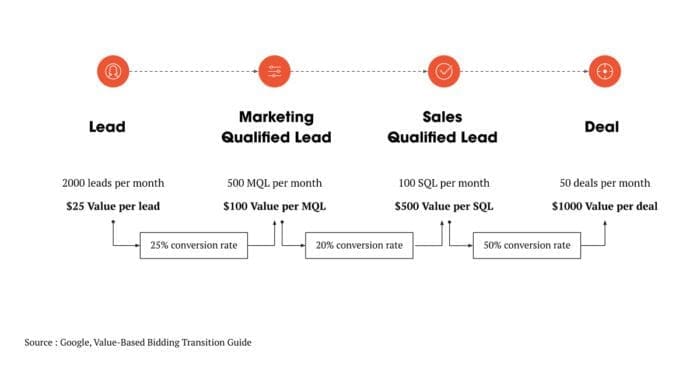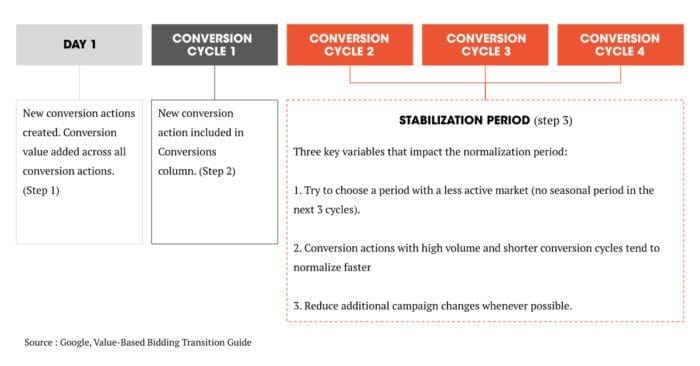This article was updated in August 2024
Value-based bidding isn’t new but there’s a brand new focus on it this year. By pairing Offline Conversion Tracking with bid strategies like Target ROAS and Maximize Conversion Value, more businesses can leverage the full benefit of these Google bid strategies to automatically prioritize ad budgets based on a prospect’s expected value.
This pairing has massive implications for companies with long marketing and sales journeys and for subscription sellers who want to target customers who will remain loyal after their initial (often discounted) purchase.
Why Use Value-Based Bidding?
Value-based bidding offers one big benefit over bid strategies that optimize towards target acquisition costs or maximize raw conversions: They let you prioritize your budget based on the true value of each customer, rather than the average value of all customers.
This means that users who share the qualities of high-value customers will be pursued more aggressively, while those who share the qualities of low-value prospects will have less budget directed their way.
The diagram below shows that by treating all types of customers the same, you run the risk of over-investing in lower-quality prospects while under-investing in your most profitable opportunities. When you prioritize segments based on value, you can maximize the return on your budget.

If you manage a B2B or subscription business, you know that not all prospects or clients are equal. Value-based bidding lets you treat them that way!
How Value-Based Bidding Paired With Offline Conversion Tracking Works
Offline conversion tracking lets you send CRM data back to Google for up to 90 days after the initial click and can be used to track actions that happen after an initial online conversion, such as a prospect turning into a won deal or a subscriber renewing for a second term. Depending on the action, you can either track these as new conversions, or you can update the value of the initial conversion as new milestones are reached.
For a direct sales business like a subscription box, you would simply pass back the true value of each customer every time they are re-billed during the 90-day window. By doing so, you’ll help Google understand which customers stay loyal, and which ones buy once and then cancel.
If your marketing efforts revolve around lead generation and lengthy sales cycles, Google recommends setting a new conversion action and defining a value for each stage in the sales journey to help their algorithm optimize for the specific actions that drive revenue.
Here is an example breakdown of the values of 4 milestones within a sales journey for a product with a $1,000 value. The four milestones we’ll track, along with the hypothetical chances that a prospect who reaches each stage completes their purchase, are as follows:
- Completes a lead form (25% of these converters participate in Discovery Calls)
- Participates in a Discovery Call (20% of these converters participate in Demo Calls)
- Participates in a Demo Call (50% of these converters become closed deals)
- Closes the deal (all of these converters are closed deals)
You can see that it is important to properly track all actions in the funnel. In order to assign the right values for each step, you need to know the conversion rate for the next stage in the funnel.
To calculate the value of each action, first, choose which conversion action is lowest in the funnel that normally occurs in the 90-day window for offline conversion tracking, then multiply the conversion rate by the value of the next step. This means working backwards from the final conversion to the initial conversion:
- A Closed Deal has a $1,000 value.
- A Demo Call has a $500 value (50% of $1,000).
- A Discovery Call has a $100 value (20% of $500).
- A Lead Form has a $25 value (25% of $100)
Knowing this, you can feed the values back to Google Ads as our prospects move from stage to stage in the sales cycle, giving the platform information about the types of prospects who have real value for your business so it can focus more on your ad spend on similar prospects while investing less on prospects who fill out forms but don’t take follow up actions. Let’s look at an example where the advertiser receives 2,000 per month:

Implementing Value-Based Bidding
Once you are tracking the values of your offline conversions in Google Ads, you can start thinking about implementing value-based bidding, either a Target ROAS or a Maximize Conversion Value bid strategy. But before you make the switch, be sure to give Google’s algorithm enough time to process the new conversion value data. This means waiting at least one month or 4 conversion cycles (whichever is longer) before switching to a value-based strategy:

Once the waiting period is over and Google’s algorithms have collected enough data to predict user behaviour, you can switch over to either a Target ROAS or Maximize Conversion Value bid strategy. Here is how to know which option is best for you when starting:
Target ROAS: You want a predictable return on your ad spend and you don’t necessarily mind spending below your expected budget when opportunities are not present. This strategy is most suited to advertisers who are sensitive to cash flow and profit margins and want a predictable return on any amount they spend.
Maximize Conversion Value: You want to spend a predictable amount each day and get the maximum return for that amount. This strategy is better suited for advertisers who are not particularly sensitive to margins but have a strict budget to maintain.
Whichever value-based bid strategy you feel is right for your business, the main takeaway is that Google Ads now offers a way for lead generation and subscription businesses to efficiently allocate their advertising budget based on expected value. If you want to learn more about these bid strategies, feel free to reach out to us.
Subscribe to The Shift Factor
Our newsletter keeps you in the know on marketing’s biggest shifts and real examples of brands adapting.




Share this: